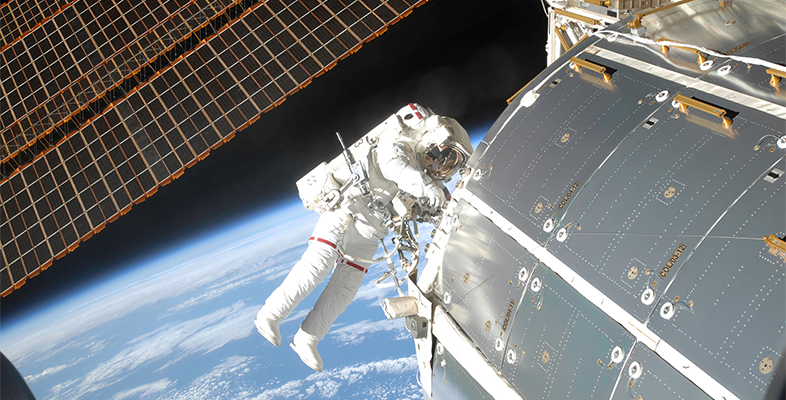5 Is there any gravity on the ISS?
‘Weightlessness’ is where you don’t experience the force of contact, for example when on a fairground ride or skydiving. It occurs when the forces are balanced. This feeling doesn’t mean that there are no forces, however. For example, parachutists reach what is known as terminal velocity when the force of gravity is equal to the air resistance. These forces are balanced, although the speed of the parachutist is high and too dangerous to land! When a parachute is opened, it increases the drag forces to the point where a lower terminal velocity is achieved, and the forces are balanced again (see Week 6).
Most people are familiar with the term ‘g-force’ which tells you how many times heavier you feel compared with the everyday experience of 1 g. Astronauts frequently train in ‘high g-force centrifuge’ environments to prepare them for space travel. But what is ‘zero-g’? The gravitational force has not disappeared but there is a feeling of weightlessness.
The correct term is microgravity. It happens whenever an object is in freefall. You now know that the ISS orbits the Earth at a distance of 400 km and travels at a speed of 28 000 km/h. Remember that the astronauts are travelling at the same speed as the ISS. Both the astronauts and the ISS are in orbit around (or about) the Earth, which also means they are in a continual state of freefall towards the Earth.
But how does gravity itself relate to masses and weights? Equation 5 shows how the weight W of an object can be calculated when you know its mass m and the acceleration due to gravity g.
If you have an object with a mass of 50 kg then, using Equation 5, you can calculate its weight (Equation 6).
Clearly, the units of weight are N, so weight is a force.
Now try the next activity, where you can calculate the weight of the same object on different planets.
Activity 7 Calculating weights on different planets
Use Equation 6 to calculate the answers to the following questions. The numerical value of acceleration due to gravity g on each planet is given.
Now you can compare the gravitational field on Earth (gEarth) with that on the ISS (gISS), to see whether there is gravity on the ISS. You will need to use Equation 7 and several physical values precise to 3 significant figures to calculate gEarth.
First, you need the value of the Earth’s mass (MEarth): this is 5.97 × 1024 kg.
Then you need the value of the Earth’s radius, rEarth: this is 6.37 × 106 m.
Finally, you need the gravitational constant G: this is 6.67 × 10-11 N m2/kg2.
With these values you can find out the gravitational field on Earth, gEarth, using Equation 7 to get a numerical value in Equation 8.
This answer is the same numerical value as the acceleration due to gravity on the Earth’s surface, which is 9.81 m/s2. Remember that the units m/s2 are the units of acceleration. In the case of Equation 8, the units are N/kg which are the units of a gravitational field.
What about the gravitational field on the ISS? To work this out you just need to add in the extra distance from the Earth’s surface to the ISS (rEarth+ISS), remembering that this is 400 km. You should now convert this to metres as follows.
400 km = 400 000 metres = 4 × 105 m.
So, rEarth+ISS = (6.37 × 106 m) + (4 × 105 m) = 6.77 × 106 m.
Equation 7 is now adapted to Equation 9 to take this extra distance into account and Equation 10 is the calculation of this gravitational field on the ISS, gISS.
Surprisingly there is not a lot of difference between the gravitational field on the ISS and the gravitational field on Earth.! On the ISS therefore, the acceleration due to gravity is not zero - and nor is the gravitational field. Therefore the term ‘zero gravity’ is a misleading one. In fact the gravitational field astronauts are ‘exposed’ to inside the ISS is almost as large as that they are exposed to on the Earth.
How does the gravitational field on the ISS compare with that on the Earth’s surface? Look at Equation 11.
The gravitational field on the ISS is approximately 89% of that on the Earth’s surface. Of course, irrespective of these facts, the astronauts on board the ISS (and even the ISS itself) feel ‘weightless’ . It is an issue of perception within the frame of reference (or place) we are in at the time. The microgravity environment on board the ISS describes the condition in which things, like the astronauts, experiments and objects all appear to be weightless. The perception that objects are weightless arises due to the orbital motion of the ISS, and the ‘balance’ between the two key forces acting on the objects - the gravitation force (pulling them ‘down to earth’) and the centrifugal force (pushing them ‘out’ in the circular motion - like the examples in the experiments above). We often use the terms 'zero gravity’ ‘weightlessness’ and ‘microgravity’ to describe the conditions the objects perceive to be experiencing - but in reality the Physics tells us there is still a large gravitational field, so the objects actually have mass, and weight. Sometimes the philosophy of science is harder than the equations!
Now complete the end-of-week quiz.
